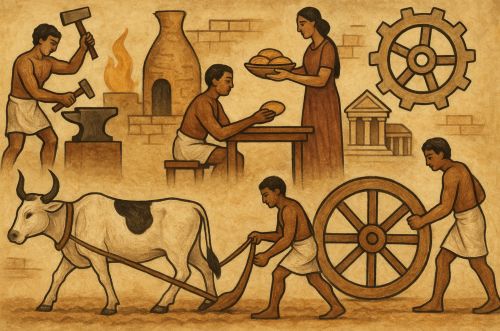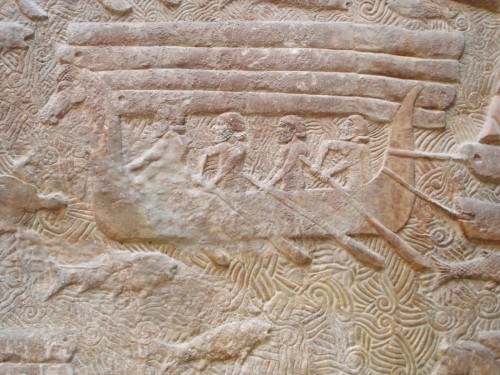

The lesson of antiquity is that technological ingenuity was never absent. What was absent were economic structures that encouraged radical transformation.

By Matthew A. McIntosh
Public Historian
Brewminate
Technology as Servant of Agriculture
In the ancient world, economies were overwhelmingly agrarian, and technological development reflected this reality. The first great civilizations of Mesopotamia, Egypt, and the Indus Valley were built not on abstract inventions but on practical solutions to agricultural challenges. Irrigation in Mesopotamia, where the Tigris and Euphrates flooded unpredictably, required elaborate canal systems, levees, and drainage works. These were not “technological leaps” in the modern sense but communal economic necessities: without them, fields turned to salt or desert.1
Egypt tells a different story. The Nile’s predictable cycle of inundation allowed a more conservative approach. Irrigation was simpler, and the state’s role in managing it less experimental. The economy, in this case, restrained technological innovation. Stability meant fewer pressures to adapt.2
Greek farms provide another instructive case. The rugged landscape of much of Greece meant agriculture depended on small plots rather than massive irrigation projects. Farmers relied on terracing hillsides, cultivating olives and vines suited to poor soils, and practicing mixed farming with sheep and goats. Animal husbandry supplied not only food but also manure, wool, and traction for plows. Here, technology was modest (wooden plows, simple presses for olives and grapes) yet deeply shaped by economic ecology. Innovation was minimal, but adaptation to environment and economic scale was constant.3
Roman agriculture, by contrast, operated on a far larger scale and was tied closely to imperial expansion. The villa system produced grain, wine, and olive oil for both local use and export across the empire. Technological advances included heavy plows for northern soils, large-scale presses for wine and oil, and improved storage facilities such as dolia (giant clay jars) and horrea (granaries). Roman estates also relied heavily on enslaved labor, which simultaneously allowed intensive exploitation of land and limited incentives to innovate mechanization. The agricultural economy of Rome thus illustrates how technology could both flourish and stall within the same framework, driven by imperial demand but restrained by its reliance on coerced labor.4
Labor, Slavery, and the Cost of Innovation

Economic structures also shaped the limits of technological ambition. In Classical Greece and Rome, where enslaved labor was abundant, elites found little incentive to mechanize. Hero of Alexandria’s ingenious devices, including a steam-powered mechanism, demonstrate that technological potential existed.5 But they remained toys and curiosities, because from an economic perspective, it was easier and cheaper to exploit human labor.
Contrast this with China, where centralized bureaucracy and different labor dynamics fostered state-directed projects. Large-scale iron production, canal networks, and hydraulic engineering reflected not only technical ingenuity but the economic logic of an empire that saw public works as essential to both stability and profit. Technology was cultivated where the economic order encouraged it.6
In the Americas, Mesoamerican societies such as the Maya and the Aztec relied on coerced labor systems that were distinct from the Mediterranean model but similarly shaped technology. The Aztecs in particular developed a tributary system in which conquered peoples provided both goods and labor for imperial projects, including temple construction and agricultural works such as chinampas (raised fields). While not “slavery” in the Roman sense, this system still limited technological incentives: vast numbers of human laborers could be mobilized for public works, reducing pressure for mechanical innovation. Economic power was expressed through organization of labor rather than through invention.7
Trade and Maritime Economies

Maritime powers like the Phoenicians remind us that trade could spur technology in distinct ways. Their refinements in shipbuilding (the development of the bireme and trireme, the use of sturdy hulls and advanced navigation) were not experiments pursued in isolation. They were driven by the economic imperative of commerce. Control of Mediterranean routes meant access to tin, copper, and luxury goods, the lifeblood of their prosperity.8
Egypt, too, was fundamentally shaped by trade, though its economy was more self-sufficient than seafaring cultures. The Nile served as a natural trade artery, carrying grain and papyrus downstream while enabling imports of cedar from Lebanon, copper from Sinai, and gold from Nubia. Egyptian shipbuilding adapted to this role, with flat-bottomed river craft and later sea-going vessels designed for Red Sea expeditions. Technological choices here were dictated not by curiosity but by the economic necessity of sustaining both state power and religious institutions through long-distance exchange.9
Greek trade illustrates another dimension of how economies dictated technology. Lacking many raw materials, Greece depended heavily on maritime exchange to secure grain from the Black Sea, timber from Macedonia, and metals from Thrace and beyond. Amphorae, the ceramic vessels used to transport wine and oil, became standardized, reflecting an economic need for efficiency in shipping and taxation. Likewise, port facilities at Piraeus and other hubs were technologically adapted to handle volume and speed, supporting Athens’ rise as a naval and commercial power. Here again, the demands of trade shaped which technologies were prioritized and refined.10
Rome, inheriting and expanding this maritime culture, likewise tied its technological prowess to commerce and war. Its fleets, roads, and bridges were not feats for posterity alone but instruments of economic control. Trade economies dictated what technologies received investment and refinement.11
In the Americas, Mesoamerican civilizations also depended heavily on trade networks, though structured differently than their Mediterranean counterparts. The Maya established long-distance exchange routes linking the Yucatán with Central Mexico, trading obsidian, cacao, salt, and jade. The Aztec economy, centered on Tenochtitlan’s great markets such as Tlatelolco, facilitated the circulation of cotton, feathers, and luxury goods across their empire. Canoe-based transport in lake systems and overland routes adapted for porters (since draft animals were absent) demonstrate how technology reflected economic necessity. These systems were innovative in context, yet they highlight again how economies, not abstract experimentation, directed technological adaptation.12
Monumental Economies and the Politics of Display

Some of the most striking technological achievements of the ancient world cannot be understood apart from political economy. These were “prestige technologies,” designed less for efficiency than for display. Their construction consumed enormous resources and manpower, justified as religious or civic necessity. The technology of transporting multi-ton stones, of aligning monuments with astronomical precision, or of building miles of aqueducts was bound to the economics of power. Monumentalism was a currency of its own.
Mesopotamian ziggurats demonstrate this dynamic vividly. Built as stepped temple towers rising above cityscapes, they required enormous labor investment and careful architectural planning, including mudbrick mass production and waterproofing techniques for rain resistance. Their purpose was not practical in the economic sense of storing goods or producing wealth, but symbolic, to link city-states to their gods and legitimize rulers. Yet the diversion of resources into their construction reveals how economies could sustain technologies of monumentalism even at the cost of material efficiency. Ziggurats thus illustrate the reciprocal bond between economy, religion, and technology in ancient Mesopotamia.13
The Egyptian pyramids stand as another example of monumental technology inseparable from economics. Constructed during the Old and Middle Kingdoms, they demanded vast resources: limestone quarries, transportation systems, skilled masons, and thousands of laborers. Far from being built by enslaved workers alone, recent evidence suggests a system of rotating labor crews drawn from agricultural populations during the Nile’s inundation season, when farming was impossible. This indicates how pyramid-building was integrated into the agrarian economy itself. The logistical organization of food, housing, and tools for workers required complex economic planning, while the pyramids themselves served as symbols of divine kingship and state power. Their endurance across millennia demonstrates how prestige projects could dominate technological effort, reinforcing social hierarchies while channeling economic surplus into monumental construction.14
Roman aqueducts reveal yet another dimension of monumentalism. Built to supply cities with fresh water, they were both functional and political symbols of Rome’s capacity to harness nature. Stretching across valleys with arcades of arches, or tunneling through mountains with precision, aqueducts required surveying instruments, concrete mastery, and coordinated labor forces. Their economic basis lay in taxation and imperial surplus, funding public works that reinforced civic loyalty and elite prestige. The Aqua Claudia or Aqua Appia were not merely utilities but demonstrations of Roman engineering as ideology, technology bound to empire and sustained by its economy.15
Conclusion: Technology as Dependent Variable
The clearest evidence that ancient technologies were bound to their economies lies in what did not happen. Water mills, for example, were known to both Greeks and Romans, and could have transformed production. But they were rarely scaled beyond local use¹⁶. The economic systems of antiquity were not structured for surplus reinvestment or industrial growth. Stability, not expansion, was the goal. In this sense, economies acted as gatekeepers, deciding which technologies were worth sustaining and which were curiosities without systemic application.
In the ancient world, technology rarely drove economies forward. Instead, economies determined the boundaries of technology. Agriculture, labor systems, trade, and politics created the contexts in which invention occurred and decided whether it spread. The relationship was reciprocal, but unequal: economies held the stronger hand.
The lesson of antiquity is that technological ingenuity was never absent. What was absent were economic structures that encouraged radical transformation. Ancient technology was not free to develop in every direction, but bound to serve the demands, anxieties, and limits of the societies that produced it.
Appendix
Notes
- Marc Van De Mieroop, A History of the Ancient Near East, ca. 3000–323 BC (Oxford: Blackwell, 2003), 41–44.
- Ibid., 61–63.
- Robin Osborne, Classical Greece, 500–323 BC (Oxford: Oxford University Press, 2000), 34–38.
- Keith Hopkins, Conquerors and Slaves (Cambridge: Cambridge University Press, 1978), 68–74.
- John G. Landels, Engineering in the Ancient World (Berkeley: University of California Press, 1977), 146–150.
- Joseph Needham, Science and Civilisation in China, Vol. 4 (Cambridge: Cambridge University Press, 1971), 112–118.
- Michael E. Smith, The Aztecs (Oxford: Blackwell, 2012), 109–113.
- Josephine Quinn, In Search of the Phoenicians (Princeton: Princeton University Press, 2017), 121–123.
- Toby Wilkinson, The Rise and Fall of Ancient Egypt (New York: Random House, 2010), 101–104.
- Ian Morris, “Economic Growth in Ancient Greece,” Journal of Institutional and Theoretical Economics (JITE) 160:4 (December 2004, 722).
- Andrew Wilson, “Machines, Power and the Ancient Economy,” Journal of Roman Studies 92 (November 2002): 1–32.
- Frances F. Berdan, The Aztecs of Central Mexico: An Imperial Society (Belmont, CA: Wadsworth, 2004), 85–91.
- Harriet Crawford, Sumer and the Sumerians (Cambridge: Cambridge University Press, 1991), 45–50.
- Mark Lehner, The Complete Pyramids (London: Thames & Hudson, 1997), 42-48.
- Trevor Hodge, Roman Aqueducts and Water Supply (London: Duckworth, 2002), 57–65.
- Wilson, “Machines, Power and the Ancient Economy.”
Bibliography
- Berdan, Frances F. The Aztecs of Central Mexico: An Imperial Society. Belmont, CA: Wadsworth, 2004.
- Crawford, Harriet. Sumer and the Sumerians. Cambridge: Cambridge University Press, 1991.
- Hopkins, Keith. Conquerors and Slaves. Cambridge: Cambridge University Press, 1978.
- Hodge, A. Trevor. Roman Aqueducts and Water Supply. London: Duckworth, 2002.
- Landels, John G. Engineering in the Ancient World. Berkeley: University of California Press, 1977.
- Lehner, Mark. The Complete Pyramids. London: Thames & Hudson, 1997.
- Morris, Ian. “Economic Growth in Ancient Greece.” Journal of Institutional and Theoretical Economics (JITE) 160:4 (December 2004), 709-742.
- Needham, Joseph. Science and Civilisation in China. Vol. 4. Cambridge: Cambridge University Press, 1971.
- Osborne, Robin. Classical Greece, 500–323 BC. Oxford: Oxford University Press, 2000.
- Quinn, Josephine. In Search of the Phoenicians. Princeton: Princeton University Press, 2017.
- Smith, Michael E. The Aztecs. Oxford: Blackwell, 2012.
- Van De Mieroop, Marc. A History of the Ancient Near East, ca. 3000–323 BC. Oxford: Blackwell, 2003.
- Wilkinson, Toby. The Rise and Fall of Ancient Egypt. New York: Random House, 2010.
- Wilson, Andrew. “Machines, Power and the Ancient Economy.” Journal of Roman Studies 92 (November 2002): 1–32.
Originally published by Brewminate, 08.20.2025, under the terms of a Creative Commons Attribution-NonCommercial-NoDerivatives 4.0 International license.


